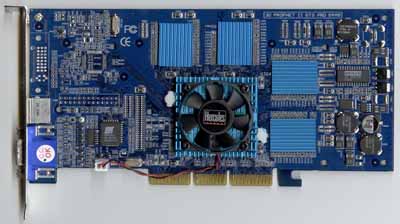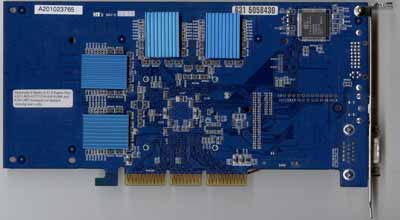The Card
The 3D Prophet II GTS Pro is manufactured by Guillemot under the Hercules name which they bought a while ago from a dying Hercules company. The board continues in this recent tradition from Guillemot by demonstrating a blue PCB along with blue heatsinks that help to set it apart from the competition aesthetically, however that doesn't buy it too much in terms of added value.
Other than the blue motif you'll also notice that the card is approximately 1" longer than the reference GeForce2 Ultra design from NVIDIA, however a great deal of space is wasted on the PCB. There are silkscreens present on the PCB that outline the missing external TMDS transmitter and its accompanying DVI port with no actual component circuitry present. The true motivation behind the 3D Prophet II GTS Pro's extra large size is the integration of a Conexant (Brooktree) BT869KRF video-out decoder chip on the card. Although the PCB's silkscreen does include an outline for the pin headers used to control the reference designed daughter board, Guillemot has chosen not to include the header but rather to incorporate the video-out chip on the back of the PCB.
 In
order to make room for the BT869 chip and the traces that run to the output
connector, Guillemot had to move the power components normally present in the
upper left hand corner of the card. It is for this reason that the 3D Prophet
II GTS Pro is longer than the GeForce2 Ultra reference design (the same one
used by the GeForce2 Pro). As you can see, the BT869 chip forces the power components
to the back of the card, extending it a full inch. Although we normally cite
larger PCB space as a waste of money, in the case of the 3D Prophet II GTS Pro,
Guillemot most likely saves quite a bit of money. This is because it is no longer
necessary to produce a separate PCB in order to allow video-output. In fact,
we have seen Guillemot use this design before in later model 3D Prophet II GTS
boards.
In
order to make room for the BT869 chip and the traces that run to the output
connector, Guillemot had to move the power components normally present in the
upper left hand corner of the card. It is for this reason that the 3D Prophet
II GTS Pro is longer than the GeForce2 Ultra reference design (the same one
used by the GeForce2 Pro). As you can see, the BT869 chip forces the power components
to the back of the card, extending it a full inch. Although we normally cite
larger PCB space as a waste of money, in the case of the 3D Prophet II GTS Pro,
Guillemot most likely saves quite a bit of money. This is because it is no longer
necessary to produce a separate PCB in order to allow video-output. In fact,
we have seen Guillemot use this design before in later model 3D Prophet II GTS
boards.
Going along with the blue motif, Guillemot includes blue memory heatsinks (RAMsinks) on each of the eight memory chips. We are not sure if the reference design calls for these heatsinks (Guillemot has used them in the past where they were not required) but we suspect that the memory heatsinks are called for by NVIDIA. It is here that we see another way that the GeForce2 Pro chip follows in the foot steps of the faster GeForce2 Ultra part. Both cards seem to require memory heatsinks in order to maintain proper operation of the memory. It seems that current memory technology can not run faster than around 166 MHz DDR while maintaining stability without some form of cooling. In the case of the GeForce2 Pro, as well as the GeForce2 Ultra, this cooling comes in the form of memory heatsinks, in this case blue ones.
Taking off the memory heatsinks, which are attached to the chips with thermal tape, reveals that the 3D Prophet II GTS Pro is powered by 5.0ns (200 MHz) EliteMT memory. The board contains a total of eight SDRAM chips with four, 8MB chips on each side of the PCB for a total of 64MB of memory.

Finally on the card side, the 3D Prophet II GTS Pro makes use of a standard heatsink and fan combination on the GeForce2 Pro core. Since the GeForce2 Pro core actually operates at the same temperature as the GeForce2 GTS, there is no reason for a heatsink or fan upgrade on Pro based cards. In fact, the 3D Prophet II GTS Pro utilizes the same heatsink and fan combination found on the 3D Prophet II GeForce2 GTS. Unfortunately, Guillemot chose to attach the heatsink and fan to the GeForce2 Pro core with only the use of side clips and a non-adhesive thermal pad. This method of heatsink attachment does not result in optimum heat transfer from the core to the heatsink; properly applied thermal grease would have done the job much better.












0 Comments
View All Comments